Excellent read. Thankful for the MIA series, as I recently purchased a refurbed ps2. Might go and grab the second Onimusha game tonight, after work.
MIA - Onimusha
The soul of the samurai was strong in this Capcom action series.

The calendar says it's Friday and you know what that means. That’s right; it’s time for another fantastic installment of Missing in Action!
This week we have a special guest taking the MIA reins in the form of PixlBit staff writer Julian Titus!
For all of you newcomers, let me explain how MIA works. MIA is a bi-weekly column where we pick out a game or franchise of old, dust it off and present it for a possible current generation entry.
To qualify for the MIA treatment the game or franchise cannot have appeared on any of the current generation platform, nor can a new title be currently in development, though unconfirmed rumors, speculation and hearsay are certainly permissible. Also the title or franchise must be well served by a current generation entry.
This week Julian presents to you for your consideration – Onimusha!

Onimusha began life as a new action/horror game in the vein of Capcom’s popular Resident Evil series. It was originally developed for the PlayStation, but with the release of the PlayStation 2 Capcom decided to scrap the PSX version and instead released the game for the PS2 in March of 2001. It was the game that convinced me to upgrade to the PS2, and it was worth the investment. The precise samurai combat coupled with a “Resident Evil in Japan” vibe made Onimusha one of my favorite games of that generation.
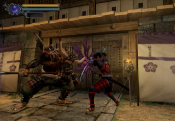 Onimusha: Warlords is a story of history merged with fantasy. In this universe, the historical Japanese figure Nobunaga Oda leads an army of undead soldiers after his death and rebirth (thanks to a deal with the demon Fortinbras). Nobunaga’s Genma warriors capture Princess Yuki of the Saito clan and it falls to our hero Samanosuke to infiltrate Inabayama Castle and save her before it’s too late.
Onimusha: Warlords is a story of history merged with fantasy. In this universe, the historical Japanese figure Nobunaga Oda leads an army of undead soldiers after his death and rebirth (thanks to a deal with the demon Fortinbras). Nobunaga’s Genma warriors capture Princess Yuki of the Saito clan and it falls to our hero Samanosuke to infiltrate Inabayama Castle and save her before it’s too late.
Although Samanosuke is a skilled samurai warrior in his own right, his steel is no match for the Genma foes he faces. He is given s special gauntlet from a clan of ogres (in Japanese, oni) that can absorb the souls of the fallen and increase Samanosuke’s power. He eventually finds powerful elemental weapons in the form of the Lightning blade Raizan, the Fire sword Enryuu, and the Wind naginata Shipuu. The weapons are all different in speed and power, and can be upgraded with souls. They also have the ability to unleash powerful elemental magic, a game mechanic seen later on in games such as God of War.
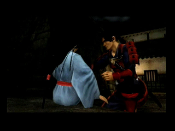 You control Samanosuke much like you would a character in any Resident Evil game from the time. The “tank” controls are in full effect here and you ready your blade just as you would ready a gun in Capcom’s other horror series. Attacks are swift, precise, and impactful. In addition to the magic attacks from your elemental weapons, you’ll also gain a bow and a matchlock rifle for ranged combat. While button mashing will get you through most encounters, Onimusha puts an emphasis on defense and counter-attacks.
You control Samanosuke much like you would a character in any Resident Evil game from the time. The “tank” controls are in full effect here and you ready your blade just as you would ready a gun in Capcom’s other horror series. Attacks are swift, precise, and impactful. In addition to the magic attacks from your elemental weapons, you’ll also gain a bow and a matchlock rifle for ranged combat. While button mashing will get you through most encounters, Onimusha puts an emphasis on defense and counter-attacks.
Onimusha: Warlords featured detailed polygonal character models set against pre-rendered backdrops. In this way, the game utilizes preset camera angles and looks like a Resident Evil game set in feudal Japan. The character of Samanosuke was modeled after popular Japanese actor Takeshi Kaneshiro, and this was something that was still relatively new to video games. While gamers in America likely had no idea who Kaneshiro was (he is the lead actor in House of Flying Daggers), the fact that the character looked like a real person made Onimusha stand out, and also showed off the power of the PlayStation 2. Onimusha: Warlords was re-released as Genma Onimusha for the Xbox in 2002.
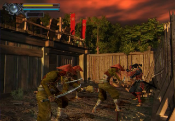 The first entry in the Onimusha series was a huge success for Capcom, and was the first game to sell over a million copies for the PS2. It was highly regarded by critics and fans alike, and it was only a matter of time before a sequel would be announced. That game would be Onimusha 2: Samurai’s Destiny.
The first entry in the Onimusha series was a huge success for Capcom, and was the first game to sell over a million copies for the PS2. It was highly regarded by critics and fans alike, and it was only a matter of time before a sequel would be announced. That game would be Onimusha 2: Samurai’s Destiny.
Released a full year after its predecessor, Samurai’s Destiny shows how quickly games could be turned around in the 6th generation of video game consoles. Even with such a quick timeframe between releases, Onimusha 2 sports much more detailed character models, a robust cast of characters, and generally more content than the first game.
 Onimusha 2 retains much of the core mechanics of the first game, but adds a few new features that add a lot of depth to the series. Jubei can block and counter attacks with the Issen move, killing enemies outright if the timing is correct. This was in the first game, but this time around it’s possible to take down an entire group of foes by chaining these attacks together. By absorbing special purple soul orbs, Jubei can transform into a powerful new Oni form, not unlike the change that Samonosuke undergoes at the end of the first game. In this form, Jubei is stronger and faster for a limited time, and can unleash a powerful area of effect attack.
Onimusha 2 retains much of the core mechanics of the first game, but adds a few new features that add a lot of depth to the series. Jubei can block and counter attacks with the Issen move, killing enemies outright if the timing is correct. This was in the first game, but this time around it’s possible to take down an entire group of foes by chaining these attacks together. By absorbing special purple soul orbs, Jubei can transform into a powerful new Oni form, not unlike the change that Samonosuke undergoes at the end of the first game. In this form, Jubei is stronger and faster for a limited time, and can unleash a powerful area of effect attack.
Jubei comes across a ragtag band of warriors that join him in battle. While they usually accompany the player as a partner, you can take control of a couple of them during certain points in the story. These supporting characters can be interacted with in the town hub of Imasho by giving them gifts you find throughout your travels. You’ll eventually encounter the burly spear-wielding monk Ekei, the young ninja Kotaro, the rifleman Magoichi, and the fencing master Oichi.
 Onimusha 2: Samurai’s Destiny was another critical darling, but it didn’t do as well commercially as the first game. It’s possible that Devil May Cry could have stolen some thunder from this game, having been released towards the end of 2001 and featuring much faster action. It’s also possible that fans had a chilly reception for the new character of Jubei. Whatever the case, the game was still successful enough to warrant another sequel and some spinoffs as well.
Onimusha 2: Samurai’s Destiny was another critical darling, but it didn’t do as well commercially as the first game. It’s possible that Devil May Cry could have stolen some thunder from this game, having been released towards the end of 2001 and featuring much faster action. It’s also possible that fans had a chilly reception for the new character of Jubei. Whatever the case, the game was still successful enough to warrant another sequel and some spinoffs as well.
The Onimusha series floundered a bit with the release of a PS2 fighting game (Onimusha Blade Warriors) and a Game Boy Advance strategy/RPG (Onimusha Tactics) before returning to form with Onimusha 3. This was the first game in the series to feature fully polygonal environments and brought in international actor Jean Reno as a secondary playable character. Onimusha: Dawn of Dreams was the last game released in the series, and went fully into the over-the-top action and aesthetic seen in other Capcom games like Devil May Cry and God Hand. It even eschewed the tradition of using a real actor as the basis for the main character, instead opting for a more anime-influenced design.
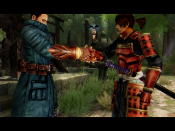 It has now been nearly six years since the release of Onimusha: Dawn of Dreams. The last real talk of another game in the franchise was an interview with series director Keiji Inafune (no longer at Capcom now) and producer Yoshinori Ono (now lead producer on the Street Fighter games). In that interview, they showed a desire to create a PSP sequel, but nothing ever came of it. A big budget movie was also in the works, with Samanosuke model Takeshi Kaneshiro reprising his role, but as of this writing, the project seems dead in the water.
It has now been nearly six years since the release of Onimusha: Dawn of Dreams. The last real talk of another game in the franchise was an interview with series director Keiji Inafune (no longer at Capcom now) and producer Yoshinori Ono (now lead producer on the Street Fighter games). In that interview, they showed a desire to create a PSP sequel, but nothing ever came of it. A big budget movie was also in the works, with Samanosuke model Takeshi Kaneshiro reprising his role, but as of this writing, the project seems dead in the water.
Even though it seems like the obvious place for a new Onimusha game to go would be into the crazy, “stylish action” area of games like Bayonetta and Capcom’s upcoming Asura’s Wrath, I think that Onimusha was at its strongest when it went for a slower, more deliberate combat mechanic. The Issen counter move was a core part of the game, and it would be interesting to see that return. Imagine a game with slower but more impactful combat, ala Dark Souls, but with a heavy emphasis on counters and deflection. It would be wise for a new Onimusha game to take some cues from the Batman Arkham games—engaging a large group of enemies and controlling them by way of countering, defense, and brutal offense would set the next Onimusha apart from its predecessors while still delivering on that excellent samurai theme and feel.
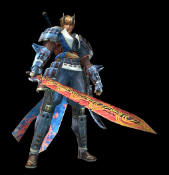 Going into deeper RPG territory would be a nice way to go. While souls will always have to play a vital role in the series, having some abilities and stats to put points into as you level up would make for a more compelling experience.
Going into deeper RPG territory would be a nice way to go. While souls will always have to play a vital role in the series, having some abilities and stats to put points into as you level up would make for a more compelling experience.
Perhaps the game could take place during the twilight of the samurai in the Meiji era. Or, the series could be taken way back to the early days of the samurai’s power. A more grounded approach to the story is sorely needed, as each game in the series got progressively more difficult to follow.
The core of the Onimusha series for me has always been the soul of the samurai. Few games have tapped this rich moment in Japanese history, and the most popular examples (Way of the Samurai and Kengo) are nowhere near as polished or as finely tuned as the Onimusha games. It’s high time for Capcom to bring this franchise back, but who would do it? Many of the important designers from the PS2 era are gone, including Keiji Inafune. Perhaps it’s time to give this series over to a Western developer, as Capcom has done with Devil May Cry. Let us know your thoughts on where Onimusha should go in the comments.




Comments